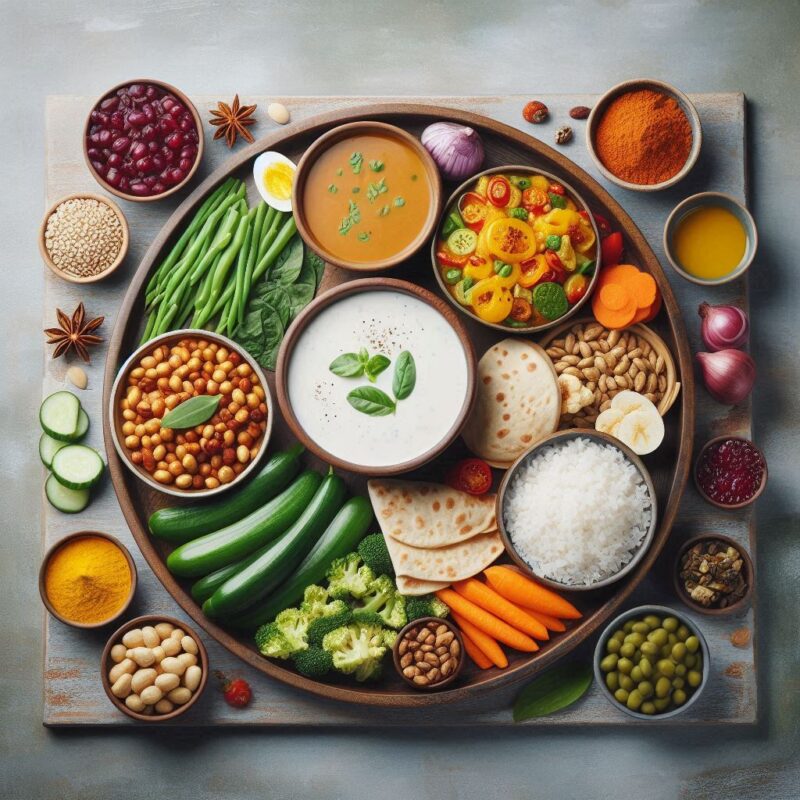Meal Plans
Balanced Indian Meal Plan for a Healthy Lifestyle

Balanced Indian Meal Plan for a Healthy Lifestyle focuses on incorporating a variety of food groups to ensure all essential nutrients are included. This plan integrates traditional Indian foods with a balance of macronutrients (proteins, fats, carbohydrates) and micronutrients (vitamins and minerals) to promote overall health and well-being.
Key Principles:
- Whole Grains: Incorporate whole grains like brown rice, whole wheat, millets (such as ragi, jowar, and bajra), and oats for slow-releasing carbohydrates that maintain energy levels throughout the day.
- Protein-Rich Foods: Include lentils, beans, paneer, tofu, eggs, fish, and lean meats. Vegetarian options can also include dal, chickpeas, rajma, and green gram (moong dal).
- Healthy Fats: Opt for healthy fats from sources like olive oil, coconut oil, ghee (clarified butter in moderation), nuts, and seeds like flaxseeds and chia seeds. These are important for heart health and brain function.
- Fruits and Vegetables: Ensure a variety of seasonal fruits and vegetables are part of each meal. This ensures fiber, vitamins, and antioxidants for overall health.
- Spices and Herbs: Use traditional spices like turmeric, cumin, coriander, ginger, garlic, and fenugreek. These not only enhance flavor but offer anti-inflammatory and digestive benefits.
- Dairy: Include low-fat dairy options like yogurt (curd), paneer, and buttermilk for probiotics and calcium. Plant-based options like almond milk and soy milk can also be included.
Sample Balanced Indian Meal Plan:
Breakfast:
- Oats Upma: Made with rolled oats, veggies (carrots, peas, onions), tempered with mustard seeds, curry leaves, and a little olive oil.
- Masala Chaas (Spiced Buttermilk): Low-fat buttermilk with cumin powder, coriander leaves, and a pinch of black salt.
- Fruit: A small bowl of mixed fruits like papaya or apple.
Mid-Morning Snack:
- A handful of almonds or walnuts.
- Herbal Tea or green tea for antioxidants.
Lunch:
- Mixed Vegetable Sabzi: Made with seasonal vegetables like spinach, cauliflower, carrots, and peas, lightly spiced.
- Whole Wheat Roti or Brown Rice: For fiber and complex carbs.
- Dal Tadka: Lentils (such as moong or masoor dal) tempered with cumin, garlic, and turmeric.
- Curd/Yogurt: A small bowl of probiotic-rich yogurt.
Evening Snack:
- Sprouted Moong Salad: Sprouted green gram with cucumber, tomatoes, onions, and lemon juice, sprinkled with chaat masala.
- A cup of masala chai (tea) with low-fat milk, sweetened lightly with honey or without sugar.
Dinner:
- Grilled Paneer/Chicken Tikka: Marinated in yogurt and spices, grilled for a protein-rich dish.
- Quinoa Khichdi: Quinoa cooked with moong dal and veggies, flavored with cumin, curry leaves, and a little ghee.
- A small bowl of raita (yogurt with cucumber or boondi).
Before Bed:
- A glass of warm turmeric milk: Milk with a pinch of turmeric and black pepper for its anti-inflammatory properties.
Tips for Following a Balanced Indian Meal Plan:
- Portion Control: Ensure balanced portions of grains, proteins, and veggies in each meal.
- Stay Hydrated: Drink plenty of water, herbal teas, and coconut water to stay hydrated.
- Limit Processed Foods: Minimize the intake of highly processed foods, sugary snacks, and fried foods.
- Physical Activity: Complement your meal plan with regular physical activity such as yoga, walking, or strength training.
- Mindful Eating: Practice mindful eating by paying attention to hunger cues and avoiding overeating.
This balanced meal plan includes a variety of nutrients that support energy levels, weight management, digestion, and overall health. It reflects the richness of Indian cuisine while maintaining a health-conscious approach.